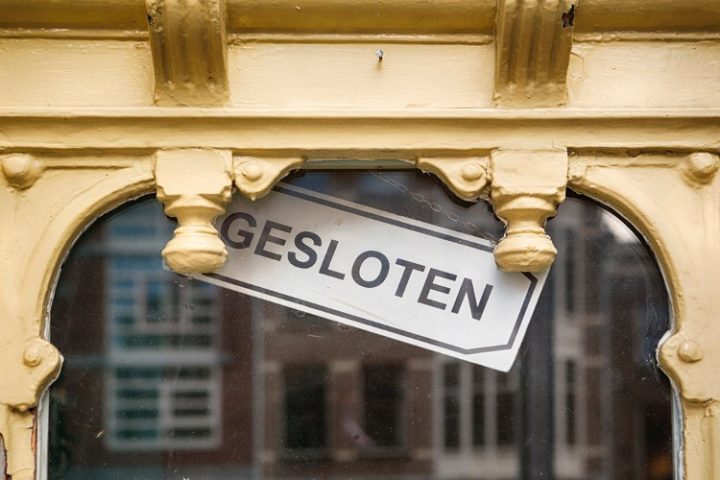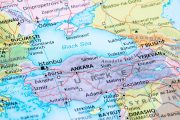
The number of companies going bankrupt across the Netherlands and Denmark, two European Union (EU) member states, has soared in the first quarter of 2023 amid skyrocketing inflation rates and high energy costs, data revealed.
According to the Faillissements Dossier, 781 companies and institutions ended up in insolvency in the Netherlands from January to March of 2023, compared to 506 in the first quarter last year, reflecting a rise of 54.3 percent, the Dutch digital newspaper De Limburger reported. Moreover, the number of cafés and restaurants that went bankrupt nearly tripled during the same period. The Faillissements Dossier linked the rise in bankruptcies in the country to remarkably high energy prices and inflation levels.
In March of this year, the Central Bureau of Statistics (CBS), a government institution that gathers and publishes statistical information about the Netherlands, reported that company bankruptcies are now rising, despite the fact that only a few companies went bankrupt during the height of the Covid-19 period. The institution also stated that the Dutch government’s Covid-19 cash payouts to keep businesses afloat temporarily limited the number of bankruptcies.
Furthermore, in an attempt to boost inflation estimates, the CBS also declared last month that it would amend the way it evaluates consumer energy prices, saying that it would use transaction data from energy suppliers to determine the real cost for consumers.
Netherlands-based credit insurer Atradius has predicted that around 4,400 firms may go bankrupt across the Netherlands in 2023, a rise of almost 80 percent, owing to factors such as rising energy costs, soaring inflation, and high wage demands. Nonetheless, Atradius forecasts that the number of insolvencies this year and next year would likely not exceed those of 2013, when the Netherlands felt the brunt of the aftermath from the 2008 global economic crisis and witnessed 12,306 companies fall into insolvency.
Despite the country’s economic woes due to the long-term ramifications of Covid-19 lockdowns as well as rising energy prices owing to the Russo-Ukraine conflict, the Dutch government of Mark Rutte has been, since 2019, introducing nitrogen restrictions on farmers and farm buildings that have prevented the expansion of dairy, pork, and poultry operations.
The ruling government’s environmental policies, implemented under the pretext of combating “climate change,” have jeopardized thousands of Dutch farmers’ livelihoods, causing widespread anger among farmers and their sympathizers.
Opposition to the ruling government, as well as support for the pro-farmer party BoerBurgerBeweging (BBB), increased as a result. In recent provincial elections on March 15, the BBB emerged victorious as it protested the ruling government’s destructive policies on Dutch agriculture and its globalist “green” agenda that threaten the country’s, as well as the world’s, food supply.
Likewise, in nearby Denmark, the number of company bankruptcies has attained a historic high unseen since the 2008 financial crisis.
During the first three months of 2023, 837 companies filed for bankruptcy in the Nordic country, marking a 40-percent increase on the previous year, Statistics Denmark reported. Notably, Danish bankruptcies in March 2023 alone cost the country 2,222 full-time positions, a 50-percent increase than the number in February.
Pointing out that transport businesses, restaurants, and construction firms have faced the brunt of the economic woes, the Danish Chamber of Commerce admitted that many restaurants closed down due to Covid-19 lockdowns as customers could not dine in and businesses had to depend on catering and deliveries for survival.
Additionally, the Chamber of Commerce cautioned that it envisaged a further increase in the number of bankruptcies in the near future.
“The higher production costs and the weaker demand will cause more companies to go bankrupt during the next six months,” the Chamber of Commerce’s senior economist, Kristian Skriver, said in a statement.
In turn, Danish analysts provided two major explanations for the slew of companies falling into insolvency.
“[The data] reflects a certain backlog of aid packages and government loans during the pandemic, which kept alive unprofitable companies that should have collapsed. Also parts of the economy are experiencing declining demand,” Palle Sorensen, chief economist at Nykredit, the country’s largest lender, opined. Sorensen also noted “challenges lurking below the surface” and said that interest-rate increases and falling private consumption were causes for worry.
Denmark’s National Bank also unveiled a recent report anticipating a slowdown for the Danish economy, highlighting the impacts that interest-rate increases have on consumption. The report added that Denmark’s tighter monetary policy is already dampening activities in the country and is poised to curtail both growth and inflation over the next year.
Notwithstanding the country’s economic problems, Denmark has been very outspoken in its military backing for Ukraine, with acting Danish Defense Minister Troels Lund Poulsen stating that Denmark, the Netherlands, and Germany will transfer the first batch of Leopard 1 tanks to Ukraine in May.
“We can expect to be able to deliver 80 to 90 tanks during 2023. They will be delivered continuously, because they need to be included in training activities with Ukrainian soldiers…. Therefore, we believe that they will be delivered in large quantities from about the beginning of May until the end of the year,” Poulsen declared.
In light of Denmark’s higher military spending following its backing of Ukraine in its conflict with Russia, the Danish government has attempted to find ways to increase tax revenues, including scrapping the Great Prayer Day, a Christian and public holiday in Denmark that originates in 1686 and falls on the fourth Friday after Easter.
In response, thousands of Danes convened in Copenhagen on February 5 to oppose the government’s plans to remove this holiday to boost the country’s military spending.
Based on estimates from the protest organizers, at least 50,000 protesters gathered in the country’s capital, making this protest the largest Denmark has seen in decades.
“The message is clear: remove the proposal,” the leader of the nation’s largest trade union, Lizette Risgaard, told Danish media, urging for talks between authorities and the people. “Everyone can see how great the popular resistance is,” she elaborated.
Her group, FH, launched a petition against the proposal, which collected more than 465,000 signatures in a country of 5.8 million.
The Ukraine conflict exhausted Denmark’s arms stockpiles and defense coffers, as Copenhagen became one of Kyiv’s staunchest allies.
Nevertheless, Denmark’s huge amounts of military aid to Ukraine undermined its goals to achieve NATO’s defense spending target of two percent of its GDP. Denmark’s coalition government (comprising the Social Democrats and the Liberals) claimed that the DKK 4.5 billion ($654 million) required to meet NATO’s goal could be raised with the extra tax revenues if the Great Prayer Day holiday was called off.
Despite popular resistance, Denmark’s beleaguered government remains dogged in its efforts to bulldoze the proposal.
“I do this with open eyes, and I think we need to be a little more honest in Danish politics,” Danish Prime Minister Mette Frederiksen said, adding that she does not see working an extra day as “problematic.”
Overall, Denmark and other Western nations have dedicated billions in arms support to Ukraine to the point of emptying their own stocks. On the other hand, Moscow has maintained that military aid to Kyiv has only served to prolong the bloody conflict.



